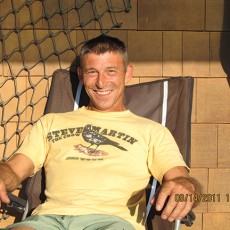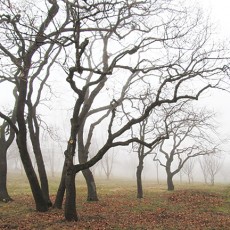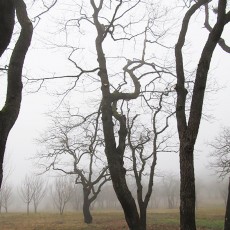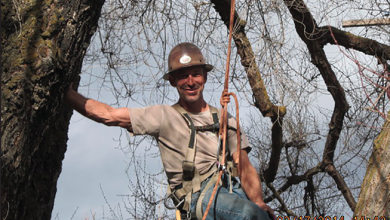Casey P. Roland: Great Tree Care
 Let’s put it this way: There are two kinds of tree work, the good kind and the bad kind. The good kind is nearly invisible and leaves your tree happy and natural looking, while the bad kind can be spotted a mile away leaving your tree looking demoralized and well, ugly. You know what I am talking about; the topped tree at the end of your road; the hacked fruit trees that got the bad haircut. Casey P. Roland offers the good kind of tree care, and if you ask him to top your tree… he won’t! It’s illegal to top your trees in Ashland. Trees take decades if not centuries to grow, and by this fact alone they should be respected and well cared for. Trees have dignity!
Let’s put it this way: There are two kinds of tree work, the good kind and the bad kind. The good kind is nearly invisible and leaves your tree happy and natural looking, while the bad kind can be spotted a mile away leaving your tree looking demoralized and well, ugly. You know what I am talking about; the topped tree at the end of your road; the hacked fruit trees that got the bad haircut. Casey P. Roland offers the good kind of tree care, and if you ask him to top your tree… he won’t! It’s illegal to top your trees in Ashland. Trees take decades if not centuries to grow, and by this fact alone they should be respected and well cared for. Trees have dignity!
Having grown up in northern California, by the age of sixteen Casey was hooked on climbing trees. He then began working with various tree care professionals, learning the tricks of the trade. One mentorship in particular shaped Casey’s opinions and approach to tree care.
Of course it’s easy to just break out the chain saw to top trees and do needless and aggressive pruning, but you don’t need to. I’m not sure if it’s just sort of guy thing that occurs when power tools are available or an overly manicured society that thinks trees didn’t know how to properly take care of themselves for the past millennia. Casey loves what he does and apparently his customers love him as well. This must contribute to the success of his thriving business gained through word of mouth alone.
I met up with Casey to talk about tree climbing, tree care and some of the added bonuses of having Casey’s professional insight and guidance around the management of your trees.
Casey thanks for speaking with me today. So what is it about trees that keeps you loving your job?
Trees are the lungs of the earth; the union between earth and atmosphere; solar powered air conditioning, and in short, the main reason for our very existence. Every tree (even if they appear identical) is different in one way or another, good or bad, deciduous or evergreen, conifer or hardwood, short or tall. So every day is a learning experience for an open minded arborist. To me, being an arborist is the best job in the world, an honorable profession. I was very fortunate to have Joseph Schneider as my mentor. He founded Pacific Tree Care in the Napa Valley. Joe is by far the best tree guy in the world, hands down, without question. His insight and connection with trees is magical. My philosophy is based upon his teachings and I will be forever grateful for our friendship. He is one of the few people in the world I would let work on my own trees.
What is the biggest similarity between trees and people?
If you were to extract a tree’s chlorophyll in its elemental makeup and substitute the magnesium with iron, and without changing any other component or ratio of the elemental makeup, you would have a red blood cell!
What is the biggest difference between trees and people?
Trees are able to manufacture their own food and people are able to move away from danger. Now, if we could just switch things around a bit…
Tell us more about the difference between good tree care and bad tree care.
Really good tree work is nearly invisible and by that I mean you can tell something has been done, but you can’t quite put your finger on it. I enhance the tree’s good points, usually by eliminating the undesirable or unnecessary ones. Pruning tools aren’t paint brushes, more like erasers, and a skilled tree care professional with a good eye can edit the superfluous parts while leaving the functional, necessary, and esthetic aspects of the tree without altering the structure and form. It takes the same amount of time to make a correct cut as an incorrect cut, but intuition and expertise comes into play here. I have found that good work sells itself. “Old School” tree work is just about dead, thank goodness! Modern arboriculture didn’t really hit the scene in the U.S. until the mid to late 70s and just blossomed from there. The great work by Dr. Alex Shigo, Rutherford Platt, James P. Jackson and other scientists who literally “wrote the book” on modern arboriculture deserve the credit for changing the way we look at trees. I urge my clients to read the works of these insightful arborists.
Ok, so what is this thing we have going in our culture with guys and their power tools. What does it look like out there from a tree care perspective?
Well, if I were king for a day, a chainsaw would require a license! Chainsaws are wonderfully loud and wonderfully efficient tools, essential for many facets of tree care, but in the wrong hands can do irreparable damage in a hurry, both to the operator, and to the tree. Power tools make our job a whole lot easier, but on a pruning job I only use them when absolutely necessary. With the exception of removals, most of my work is done by hand.
 Trees leaning toward homes are a big issue for you. Talk to us about it. When is it OK, when is it not… and what needs to be done?
Trees leaning toward homes are a big issue for you. Talk to us about it. When is it OK, when is it not… and what needs to be done?
Lucky for us, trees are very benevolent. Oftentimes, we subject trees to abuse and/or neglect, expecting them to survive in hostile cultural conditions and for the most part, they take it in stride, without complaint. Left to their own devices, every tree on earth eventually does one of two things, either croak and fall over, or fall over and croak. There is not a lot you can really do to change that, because as we all know, eventually, what goes up will come down. I don’t want to appear to be an alarmist, but if you choose to live within striking distance of a large, leaning tree, it is a good idea to have a risk assessment inspection by an experienced tree care professional. And just because a tree leans in a specific direction doesn’t mean that it needs to be removed, of course, as there are no perfectly “balanced” trees per se, and with sufficient anchorage most fair very well, even in high wind events. The soils encompassing the root zone and condition of the roots opposite the lean are the most critical factors in determining risk. You can eliminate the target, or eliminate the hazard, or attempt to mitigate the hazard and assume the risk and consequence of structural failure. Half of all trees are under ground. While dealing with above ground issues is easy, because they are tangible, roots are kind of a guessing game. In short, put your money where your roots are!
Please give us a brief overview of the services you provide.
My service is first and foremost, education. Understanding how a tree functions in its everyday life and passing that knowledge along to my client is the most valuable service I can provide, and I do that for free! In no specific order, I also offer pruning, restoration after improper “pruning,” planting and early care, structural enhancement (bolting and propping), removal, improvement of cultural conditions within the root zone, consultation, appropriate species selection, irrigation and fertilization guidelines, and protection before and during construction.
You love the work you do and it seems that your clients also love working with you. Please talk more about this.
I don’t B.S. my clients, and I won’t compromise quality. I have dedicated my life to taking good care of trees. I spend a fair amount of my time talking people out of unnecessary pruning jobs. I think people really appreciate my honesty. My greatest satisfaction comes from the opportunity to tell a potential customer that they should spend their money on a mini-vacation or a night out on the town with their significant other, and call me in a couple of years for an assessment! I just won’t sell a job that isn’t vital or needed, and I take a “less is more” attitude when I can. That approach has sold more work from word of mouth than anything else! Remember, if it’s not broken…
So, tell us about the topping of trees in Ashland, is it really illegal?
Thankfully, as with many cities around the country, it is a violation of local ordinance to “top” a tree. There are exceptions such as eliminating interference with overhead electrical conductors, removing dead or structurally compromised portions of a tree, and fruit tree pruning of course. There is really a fine line between topping and “crown reduction” and a difficult call to make. There are standards set by various organizations with differing opinions, formulas, and ratios concerning the definition of ‘topping.” The city of Ashland has begun taking a more vigorous stance toward sub-standard work, with fines and penalties, and rightly so! After all, we have a “Tree City U.S.A.” status to live up to, and who really wants to look at a bunch of hacked trees anyway? It is very easy to keep a big tree small (heck, even a deer can do it!), but almost impossible to make a big tree small…The #1 reason why people top trees, is because the tree, most of the time will survive the calamity! Trees by their very nature are survivors, but a topped tree losses its dignity and its structural integrity will be compromised making for a potentially hazardous situation that is extremely difficult, if not impossible to correct.
Describe a job well done.
I have pulled trees out of some pretty vicious downward spirals, mostly due to unfavorable cultural conditions within the root zone. Restoration of previously “butchered” trees also comes to mind. I would like to think that all my jobs are well done.
 You mention that one of the best things someone can do for future generations is to plant a tree. Can you say more about this?
You mention that one of the best things someone can do for future generations is to plant a tree. Can you say more about this?
I think planting a tree has to be one of the most selfless acts in the world. Look at all the beautiful trees in Ashland that we enjoy, and all because someone, at some time, decided to plant a tree that in all probability they would not see at its maturity. Perhaps we take for granted that the urban forest we love so much was not much more than a mud pit at the turn of the century! Look at the old photos from the historical society, a lot of horse drawn carriages, 3 or 4 sawmills in town, and nary a tree in sight. Can you imagine Lithia Park with no trees? Trees are finite beings, so we need to ensure that down the road there will be the same, if not more beauty in our world that we are fortunate enough to experience every day. I really get a kick out of planting trees with children on Arbor Day, and envision that maybe many years from now, they will visit the tree they planted and reflect back on the day we spent making Ashland a beautiful place to live.
You also talk about there being a great community of “Tree Care Professionals” here in Ashland. Can you talk more about this?
There are still a few “hacks” around, for sure, but we are fortunate to be amongst some of the best arborists in the country! I have found that good work begets good work. News travels fast in a small town, and Ashland is no exception. I am happy to recommend some other local arborists for jobs that are out of the scope of what I do.
Casey, what are some of the things we have been taught to do with trees that we really shouldn’t do?
People tend to want to “fix” things. Back in the day, tree work consisted of strapping on a set of “hooks” (climbing spurs), stomping holes up the trunk to some predetermined height, whipping out the trusty chainsaw, and cutting off the top. We would then apply an asphalt based sealant in an attempt to combat the decay that was sure to flourish as a result of the cut! If the tree survived long enough to regenerate a new poorly formed crown, we would then install cables to hold the whole mess together. Yes, I cringe to think I was guilty of all the above many years ago, when I first started out. I didn’t know any better back then, but have seen the error of my ways! I hope those trees can forgive me. Don’t even get me started on the practice of injecting trees with whatever the “flavor of the month” is…
Please talk about the pros and cons of cabling.
Static cable installation is hopefully going the way of the dinosaur. In my opinion, it is usually unwarranted at best and detrimental at worst. I have installed my fair share of cables in the past, and it always kind of nagged my conscience to do so. Trees have a very dynamic method to their movement, as it were, and I don’t believe changing those frequencies is such a good idea. As such, I no longer install or maintain static cabling due to liability issues and personal reasons. I am, however, a huge fan of propping, as well as through-bolting. I have never seen these treatments fail, but can recall many failed cables throughout my career.
Do you have a favorite tree and can you tell us about it?
You just had to ask that one! I assume you mean a specific tree and not what kind. I have to say I’m an oak kind of guy, but really love all types of trees. There are many trees that hold special significance in my life, so can I just narrow it down to a hundred or so? The Henley Oak, The Patton Pine, The Flag tree, The Wilsey Oak, The Whiskey Fir (Douglas Fir), The Middle Eel Oak, Sugar Mama, The Salt Spring Oak, to name a few…And no, I won’t say where they are, but we can go visit them if you like…
 Some of my best childhood memories involved playing in trees, playing under them or being around them.
Some of my best childhood memories involved playing in trees, playing under them or being around them.
I like to think that everyone has fond tree memories from their childhood, and I’m no exception! The smell of Privet flowers in the summer takes me back to Petaluma, CA in 1976! The coolest part about being an arborist is that you get to be a kid everyday! Just imagine being able to tell someone that you climb trees for a living… I should also add that I’m a big fan of tree houses!
What have been some of the most challenging jobs you have tackled?
It’s probably hard to believe but I’m acutely acrophobic. I can’t stand being on a roof, ledge, cliff, or bridge because I feel like I’m being sucked over the edge! Facing that demon everyday has been quite a challenge for me. I’m sure it shocks people when I explain to them that I’m scared to death of heights, but I enjoy trees and tree work so much, it is worth it. I have worked in some pretty hairy trees over the years, but there are about half a dozen that really stand out in my mind. All of the various ropes, rigging, tools and equipment that I utilize in my work is over engineered, designed, tested, rated, and otherwise bombproof. The trees I work with, on the other hand, are not. I have been in trees that failed at the worst possible moment, and that really sucks! As arborists, we play it as safe as we can, but hanging from a 1/2’’ rope 150’ off the ground, with a running chainsaw in hand is kinda dangerous, but I wouldn’t trade jobs with anybody!
You are on the City of Ashland Tree Commission. Can you talk more about this?
Be the change you’d like to see, right? I am a champion for the trees, and they need a voice! I’m sort of the black sheep of the commission as I tend to be a tad bullish in my opinions, but I figure the squeaky wheel gets the grease! We are fortunate in that we have very dedicated and competent tree people on the commission. We are just an advisory panel, but have made suggestions on planning actions that have been taken to heart. There are various ordinances protecting trees in our community and we review actions with site visits and subsequent round table discussions. We also organize Arbor Day celebrations, usually with a tree planting ceremony, and accept bribes for the “tree of the year” nomination (just kidding).
Any good tree jokes, lore or wisdom you care to share with us?
The three top questions I’ve been asked over the years:
Q: “When is the best time to prune my tree?”
A: “About 3 days before my rent is due.”Q: “Have you ever fallen out of a tree?”
A: “No Ma’am, we only get paid to go up.”Q: “Have you been doing tree work your whole life?”
A: “Not yet…”
Moving into spring you tend to be a very busy guy. How can we go about getting you out to our place?
Give me a call. I usually answer my phone personally, and will return my voicemail messages within 24 hours. I don’t charge for the initial visit or cost estimates. If you would like me to tell you what you want to hear, my rate is $1,000.00 per hour, but I’ll give you the truth for free.
Finally, any last words or comments you would like to share with our readers?
Trees get to be thousands of years old and hundreds of feet tall, and they do that without human influence. When we place trees in our environment, or we move into theirs, we owe it to them to make life as comfortable for them as possible. They sure do the same for us…
Learn More:
Casey P. Roland Tree Care
541-488-0782


